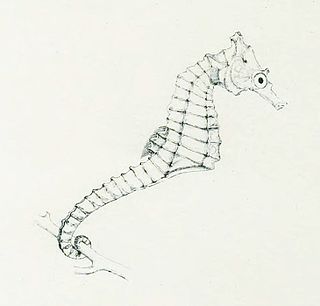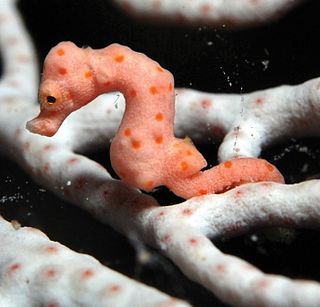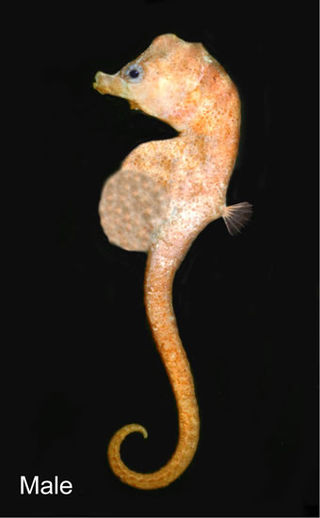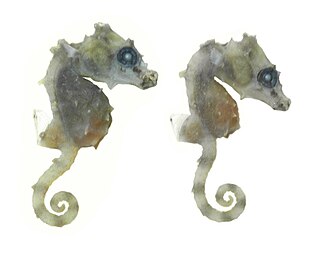
Hippocampus angustus, commonly known as the narrow-bellied seahorse, western Australian seahorse, or western spiny seahorse, is a species of marine fish of the family Syngnathidae. It is found in waters off of Australia, from Perth to Hervey Bay, and the southern portion of Papua New Guinea in the Torres Strait. It lives over soft-bottom substrates, adjacent to coral reefs, and on soft corals at depths of 3–63 metres (9.8–206.7 ft). It is expected to feed on small crustaceans, similar to other seahorses. This species is ovoviviparous, with males carrying eggs in a brood pouch before giving birth to live young. This type of seahorse is monogamous in its mating patterns. The males only fertilize one female's eggs for the mating season because of the population distribution. While some seahorses can be polygamous because they are denser in population, this type of seahorse is more sparsely distributed and the cost of reproduction is high. Therefore, the risk to reproduce due to predatory and distributary factors limits this breed to one mate, often finding the same mate season after season.

The knobby seahorse, also known as the short-headed seahorse or short-snouted seahorse, is a species of marine fish of the family Syngnathidae. It inhabits coastal waters in southwestern and southeastern Australia, from Gregory to Bremer Bay, and from Denial Bay to Newcastle.

The giraffe seahorse is a species of fish of the family Syngnathidae. It is found in coastal waters off of the south and east coasts of Africa, from South Africa to Tanzania, and possibly north to Kenya. It lives in estuarine seagrass beds, algae beds, and shallow reefs to depths of 45 metres (148 ft), where it can grow to lengths of 10 centimetres (3.9 in). It is expected to feed on small crustaceans, similar to other seahorses. This species is ovoviviparous, with males carrying eggs in a brood pouch before giving birth to live young. Individuals are sexually mature at around 6.5 centimetres (2.6 in). Major threats to this species could be habitat loss, through coastal development and pollution, and overexploitation through bycatch. Some other threats include human use by drying out the seahorse for traditional medicine or as a curio.

Hippocampus coronatus, commonly known as the high-crowned seahorse or crowned seahorse, is a species of fish of the family Syngnathidae. It is endemic to the Pacific coastal waters of Japan, where it lives among Zostera seagrasses. It can grow to lengths of 10.8 centimetres (4.3 in), but is more commonly 6 centimetres (2.4 in). Individuals feed mainly on small crustaceans such as gammarid amphipods and copepods, although this can vary by size, with smaller individuals consuming copepods while larger individuals feed on amphipods and mysids. This species is ovoviviparous, with males brooding eggs in a brood pouch before giving birth to live young. Breeding season occurs from June to November, with females and males reaching sexual maturity at 6.9 centimetres (2.7 in) and 7.3 centimetres (2.9 in) respectively. Male brood size ranges from 12–46. The International trade in this species has been monitored through Appendix II of the CITES licensing system since 2004 and a minimum size of 10 centimetres (3.9 in) applies to traded specimens.

Hippocampus denise, also known as Denise's pygmy seahorse or the yellow pygmy seahorse, is a seahorse of the family Syngnathidae native to the western Pacific.

Hippocampus fisheri, commonly known as Fisher's seahorse, or the Hawaiian seahorse, is a species of fish of the family Syngnathidae. It is known from the Hawaiian Islands, although previous misidentifications indicated species occurrences in Australia and New Caledonia. Habitat preferences are unknown, but it has been found far away from shore and at depths greater than 100 metres (330 ft). Feeding habits are also unknown, but individuals are expected to feed on small crustaceans similar to other seahorses. Hippocampus fisheri is one out of the three species of Hippocampus genus found in the Hawaiian islands. They are also expected to be ovoviviparous, with males carrying eggs in a brood pouch before giving birth to live young. Individuals can grow to lengths of 8 centimetres (3.1 in). The specific name and the common name honour "Walter V. Fisher” of Stanford University. There was a Walter Kenrick Fisher who was Jordan and Evermann's colleague at Stanford and the “V” is assumed to be a typo.

Hippocampus guttulatus, commonly known as the long-snouted seahorse and in Great Britain as the spiny seahorse, is a marine fish belonging to the family Syngnathidae, native from the northeast Atlantic, including the Mediterranean.

Jayakar's seahorse is a species of coastal fish of the family Syngnathidae. It is found in the Western Indian Ocean, from the Red and Arabian seas to the central coast of Pakistan. It lives in seagrass beds, algae, soft-bottom substrates, sponges, and rocky habitats, where it can grow to lengths of 14 centimetres (5.5 in). It can inhabit depths to 20 metres (66 ft), though it is more commonly found at 2–3 metres (6.6–9.8 ft). It is expected to feed on small crustaceans, similar to other seahorses. This species is ovoviviparous, with males carrying eggs in a brood pouch before giving birth to live young. Individuals reach sexual maturity at 11 centimetres (4.3 in). The specific name and the common name honours the Indian physician, linguist and ichthyologist Dr. Surgeon-Major Atmaram Sadashiv "Muscati" Jayakar (1844-1911).

The bullneck seahorse is a pygmy seahorse in the genus Hippocampus. This seahorse has never been found in the wild, and little is known about its natural habitat. The only known specimens were collected on the coast of Eden, Australia. It is thought to live in sand beds at the bottom of the ocean, "64 - 100 meters below sea level" possibly wrapping its prehensile tail around gorgonian corals. The seahorse is among the 25 “most wanted lost” species that are the focus of Re:wild's “Search for Lost Species” initiative.

Shiho's seahorse or Sindo's Seahorse, painted seahorse is a species of fish in the family Syngnathidae. It is endemic to the Pacific coastal waters of Japan. This species reaches a length of ca. 8 cm. It was listed by the IUCN Red List as Vulnerable in 1996 and Data Deficient in 2003, but was later reclassified as Least Concern. The specific name honours Michitaro Sindo, who was originally from Yamaguchi and who was assistant curator of fishes at Stanford University.

The hedgehog seahorse is a species of fish of the family Syngnathidae. It inhabits coastal waters from India and Sri Lanka to Taiwan and northern Australia. It is threatened by overfishing, as both targeted catch and bycatch. This species is ovoviviparous, with males carrying eggs in a brood pouch before giving birth to live young.

The tiger snout seahorse or West Australian seahorse, is a species of fish in the family Syngnathidae. It is endemic to south-western Australia, where it occurs from the Abrolhos Islands to Rockingham. Its natural habitats are the edges of rocky areas, muddy bottoms and areas with murky water caused by high sediment load, around jetty pilings and moorings; it is often associated with sponges or sea squirts and frequently attaches itself to man-made objects. In the winter they move to deeper water.
The false-eye seahorse, or flatface seahorse is a species of marine fish of the family Syngnathidae. It is endemic to Australia, from Shark Bay to Broome, where it is found in intertidal rockpools, shallow algae and weedy or rubble reef habitats. It is expected to feed on harpacticoid, calanoid, and cyclopoid copepods, caridean and gammaridean shrimps, and mysids, similar to other seahorses. This species is ovoviviparous, with males brooding eggs in a brood pouch before giving birth to live young.

Satomi's pygmy seahorse is the smallest known seahorse in the world with an average length of 13.8 millimetres (0.54 in) and an approximate height of 11.5 millimetres (0.45 in).
Hippocampus tyro is a seahorse, a fish in the family Syngnathidae. The species is only known from a single specimen caught off of the coast of the Seychelles at a depth of between 43 and 48m.

Coleman's pygmy seahorse is a species of fish of the family Syngnathidae. It is found off of the coast of Lord Howe Island, Australia, although unconfirmed occurrences have been reported from Milne Bay and the Ryukyu Islands. It lives in coarse sand and Zostera and Halophila sea grasses at depths around 5 metres (16 ft). It is expected to feed on small crustaceans, similar to other seahorses. Ovoviviparous reproduction is also expected, with males brooding eggs in a pouch before giving birth to live young.
Hippocampus jugumus, the collared seahorse, was described in 2001 from a single specimen found in the waters surrounding Lord Howe Island.
Hippocampus debelius, commonly known as the softcoral seahorse, is a species of marine fish of the family Syngnathidae. It is known from only two specimens collected from the Gulf of Suez in the Red Sea, at depths of 15–30 metres (49–98 ft). Individuals were found associated with soft corals. Although little is known of this species, it is expected to feed on crustaceans, similar to other seahorses. It is also expected to be ovoviviparous, with males carrying eggs in a brood pouch before giving birth to live young.
Hippocampus casscsio, the Beibu Bay seahorse, is a species of marine fish of the family Syngnathidae. It is found off the coast of Hainan, China, and from sites around Beibu Bay/the Gulf of Tonkin. It inhabits shallow coastal waters to depths of 15 metres (49 ft). It is expected to consume small benthic and planktonic crustaceans such as copepods, shrimps, and mysids, similar to other seahorses. This species is ovoviviparous, with males brooding eggs in a brood pouch before giving birth to live young. It grows to a length of 13.3 centimetres (5.2 in).
Hippocampus dahli is a fish species of the family Syngnathidae. It is endemic to the Australian northeastern coast, from Darwin to Brisbane, where it inhabits estuarine channels and rubble or soft substrates to depths of 21 metres (69 ft). Little is known of its feeding habits, but it is likely to feed on small crustaceans such as copepods, amphipods, and gammarid, caprellid, and caridean shrimps, similar to other seahorses. This species is ovoviviparous, with males carrying eggs in a brood pouch before giving birth to live young. This species is not listed in FishBase and many authorities treat it as a synonym of Hippocampus trimaculatus.














